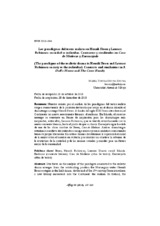Mostrar el registro sencillo del ítem
Los paradigmas del teatro realista en Henrik Ibsen y Lennox Robinson: sociedad vs individuo. Contrastes y similitudes en Casa de Muñecas y Encrucijada
| dc.contributor.author | Osuna Osuna, María Teresa | |
| dc.date.accessioned | 2019-05-10T10:30:25Z | |
| dc.date.available | 2019-05-10T10:30:25Z | |
| dc.date.issued | 2018 | |
| dc.identifier.issn | 2386-9658 | |
| dc.identifier.uri | http://hdl.handle.net/10396/18507 | |
| dc.description.abstract | Nuestro interés por el análisis de los paradigmas del teatro realista surge a consecuencia de la posición destacada que ocupa en el drama irlandés el dramaturgo noruego Henrik Ibsen. A finales del siglo XIX Ibsen introduce en el Continente un nuevo movimiento literario: el realismo. En Irlanda, el maestro noruego se convierte en fuente de inspiración para los dramaturgos más incipientes, entre ellos, Lennox Robinson, que se vincula estrechamente con la nueva corriente literaria, hasta el punto de que su drama Encrucijada sigue la estela de una de las obras cumbre de Ibsen, Casa de Muñecas. Ambos dramaturgos estudian el conflicto del individuo consigo mismo y con la realidad social cuando busca su propia liberación. En ambos dramas descubrimos la superioridad moral de la mujer sobre el hombre en su lucha por alcanzar un objetivo: la reforma de la estructura de la sociedad y de las normas sociales y morales para un futuro mejor de la comunidad. | es_ES |
| dc.description.abstract | Our focus on the analysis of the paradigms associated to the realistic drama emerges from the outstanding position the Norwegian writer Henrik Ibsen occupies in the Irish drama. At the end of the 19th century Ibsen introduces a new literary movement into the Continent: the realism. In Ireland, the Norwegian master becomes a source of inspiration for the beginning writers. Among them there is Lennox Robinson, who closely links up to the new literary movement, to the extent that his play The Cross Roads follows the line of one of Ibsen´s masterpieces, A Doll´s House. Both playwrights study the conflict within the individual and with the social reality around while that is searching for his own liberation. Both plays show women´s moral superiority over men in their fighting for reaching a common objective: the structure of society as well as the social and moral rules to be reformed for a better future for our community. | es_ES |
| dc.format.mimetype | application/pdf | es_ES |
| dc.language.iso | spa | es_ES |
| dc.publisher | UCOPress | es_ES |
| dc.rights | https://creativecommons.org/licenses/by/3.0/ | es_ES |
| dc.source | Alfinge 30, 107-124 (2018) | es_ES |
| dc.subject | Ibsen, Henrik, 1828-1906 | es_ES |
| dc.subject | Robinson, Lennox | es_ES |
| dc.subject | Drama social | es_ES |
| dc.subject | Irlanda | es_ES |
| dc.subject | Realismo (corriente literaria) | es_ES |
| dc.subject | Casa de Muñecas (obra de teatro) | es_ES |
| dc.subject | Encrucijada (obra de teatro) | es_ES |
| dc.subject | Social drama | es_ES |
| dc.subject | Ireland | es_ES |
| dc.subject | Realism (literary movement) | es_ES |
| dc.subject | A Doll´s House (play) | es_ES |
| dc.subject | The Cross Roads (play) | es_ES |
| dc.title | Los paradigmas del teatro realista en Henrik Ibsen y Lennox Robinson: sociedad vs individuo. Contrastes y similitudes en Casa de Muñecas y Encrucijada | es_ES |
| dc.title.alternative | The paradigms of the realistic drama in Henrik Ibsen and Lennox Robinson: society vs the individual. Contrasts and similarities in A Doll´s House and The Cross Roads | es_ES |
| dc.type | info:eu-repo/semantics/article | es_ES |
| dc.relation.publisherversion | https://www.uco.es/ucopress/ojs/index.php/alfinge/index | es_ES |
| dc.rights.accessRights | info:eu-repo/semantics/openAccess | es_ES |

